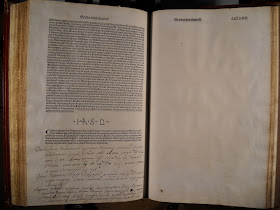 Hartman Schedel's Liber Cronicarum (Nuremberg: Anton Koberger, 1493) is one of the most beautiful and best known books from the incunabula period. Using the medieval concepts of ages of the world, it was designed to chronicle the
history of the world from start to finish. As a genre, it was not new--chronicles of this sort had been around for a long time in manuscript form. But the printed book posed a problem. In 1493, the world was still in its Sixth Age that would not come to a close until the second coming of Christ, but the Nuremberg Chronicle (as it is commonly known) wanted to be complete and portray the final ages of the world as well.
Hartman Schedel's Liber Cronicarum (Nuremberg: Anton Koberger, 1493) is one of the most beautiful and best known books from the incunabula period. Using the medieval concepts of ages of the world, it was designed to chronicle the
history of the world from start to finish. As a genre, it was not new--chronicles of this sort had been around for a long time in manuscript form. But the printed book posed a problem. In 1493, the world was still in its Sixth Age that would not come to a close until the second coming of Christ, but the Nuremberg Chronicle (as it is commonly known) wanted to be complete and portray the final ages of the world as well.The printer came up with a simple solution, blank pages between the end of the Sixth Age and the start of the Seventh Age which would usher in the Apocalypse. But how many pages? If you were trying to predict how much history might transpire between now and the end of the world, how many blank pages, or volumes, would you leave? Tellingly, the printers left just six blank pages to take the book's buyers to the end--surely that would have been enough to carry history to 1500, a date widely touted as the beginning of the end.
You can see one of our copies of the Nuremberg Chronicle on display in the Berry Main Street exhibition, On the Eve of Destruction (Again), now through November. Or, ask for Incunabula 112 to see it in the Reading Room.

No comments:
Post a Comment